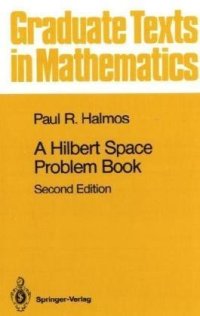
Ebook: A Hilbert Space Problem Book
Author: P.R. Halmos
- Genre: Mathematics
- Series: Graduate texts in mathematics 19
- Year: 1982
- Publisher: Springer
- Edition: 2nd rev. and enlarged ed.
- Language: English
- djvu
There are so many interesting discussions in this book that to list them all would probably entail listing everything in the book. The reader will find excellent discussions of the origin of normal operators on infinite dimensional Hilbert spaces as analogs to matrices on finite dimensional spaces; why the weak topology in infinite dimensions is not metrizable; the non-emptiness of the spectrum and why the spectral radius can be computed even though the spectrum cannot; the impossibility of isolated singular operators; the non-continuity of the spectrum: the existence of an operator with a large spectrum and the existence of operators with small spectra in every neighborhood of the large spectrum. The author then goes on to show that the spectrum is an upper semicontinuous function, thus preventing the existence of small spectra arbitrarily close to large spectra. This is an excellent discussion on the meaning and intuition behind semicontinuity; the result that every normal operator is unitarily equivalent to a multiplication and its equivalance to the spectral theorem. The author goes on to explain how one gives up the sigma-finiteness of the measure when doing this, and the origin of functional calculus; the difference between infinite and finite dimensions when attempting a polar decomposition for operators and its connection with partial isometries; the origin of compact operators and their connection with integral equations. The author shows how even the identity operator is not an integral operator on the space of square-integrable functions with Lebesgue measure.
In discussing the spectral theorem in chapter 13 the author states most profoundly: "In some contexts some authors choose to avoid a proof that uses the spectral theorem even if the alternative is longer and more involved. This sort of ritual circumlocution is common to many parts of mathematics; it is the fate of many big theorems to be more honored in evasion than in use. The reason is not just mathematical mischievousness. Often a long but 'elementary' proof gives more insight, and leads to more fruitful generalizations, than a short proof whose brevity is made possible by a powerful but overly specialized tool." In these few sentences the author has characterized the problem with current methods of teaching advanced mathematics. Too often the formalism masks the true meaning and intuitive motivation behind the mathematics. And even though mathematics is being applied to many different areas at an unprecedented rate, pure mathematics seems to be trapped in a local minimum, and I beleive this is due to the reluctance of authors to explain in detail the essentials of their ideas. This book is a perfect example of how mathematics can be taught that requires much thought and creativity on the part of students, without spoon-feeding them and thus encouraging a passive attitude to the learning of mathematics. I salute the author in his achievements in research and in teaching...one can only hope that his approach will